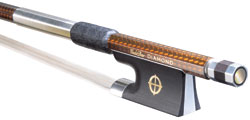A new bow can have an immediate and dramatic effect on your playing for a relatively modest investment. Many players do not realize how much they are held back by a bow that no longer meets their needs and skill level. Call a SHAR Violin Shop representative today at 866.742.7270. They can play-test and assist you in selecting the right bow to help you break through to the next level of performance. And please check out our other articles in the series, "Do I Need a New Bow?" and "The Most Common Bow Materials."
 The musical sounds which come out of a bowed stringed instrument result from the three-way interaction of the instrument, bow, and player. Change any one of the three and the resulting music can be noticeably different. You can easily determine a bow's compatibility with a specific instrument and player using this simple progression of tests:
The musical sounds which come out of a bowed stringed instrument result from the three-way interaction of the instrument, bow, and player. Change any one of the three and the resulting music can be noticeably different. You can easily determine a bow's compatibility with a specific instrument and player using this simple progression of tests:
1. Regardless of a player's ability level, it is essential that you are pleased with the bow's basic tone color production and compatibility with the instrument. Play a scale or short excerpt (without vibrato) paying attention to:
- Desirability of tone color
- Clarity of tone production
- Uniformity of tone from frog to tip, and the feel that a well-tracking bow settles into the string (particularly important in double-stop and chord playing)
A bow must do all these well in order to make an instrument and player happy. Any bow which does not should be eliminated from further consideration.
2. As playing advances, you take advantage of a bow's ability to control tone color range and dynamic range. Play a scale or short excerpt with vibrato and a wide range of dynamics while paying attention to:
- Ability to play both loud and soft with a minimum of surface noise
- Effectiveness of down-bow crescendos all the way to the tip (since up-bow crescendos are easy)
A bow must do all of these well in order to help a player develop musically.
3. As bowing ability increases, you become particularly aware of a bow's ability to control off-the-string strokes and clarity of the attack. Play a scale or short excerpt with a variety of bow strokes while paying attention to:
- Quickness of response
- Relative absence of surface noise
- Purity of tone
- Ease of increasing the speed of the stroke
A bow must do all of these well in order to help a player develop stylistically. A recommended stroke at this stage of testing is the ricochet, because by virtue of its speed, it is a stroke which need not, and cannot, easily be forced into "behaving" by the player.
4. After a bow has successfully passed the above tests, it should be subjected to a comparison with the existing bow. One of the most important reasons for a developing player to purchase a new bow is that the playing characteristics of the old bow (tone production, compatibility with a new instrument, and contribution to musical and stylistic growth) have been outgrown. Repeat the above tests directly comparing the new bow to the old bow.


